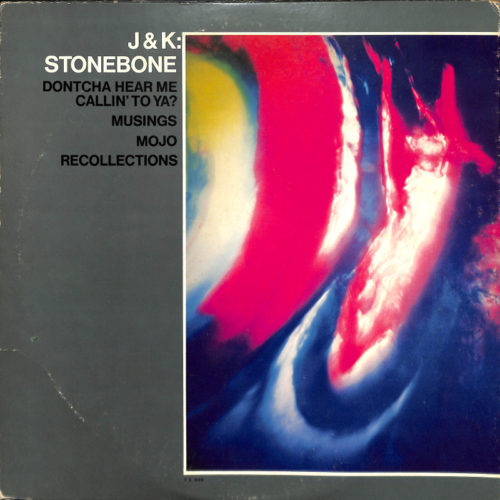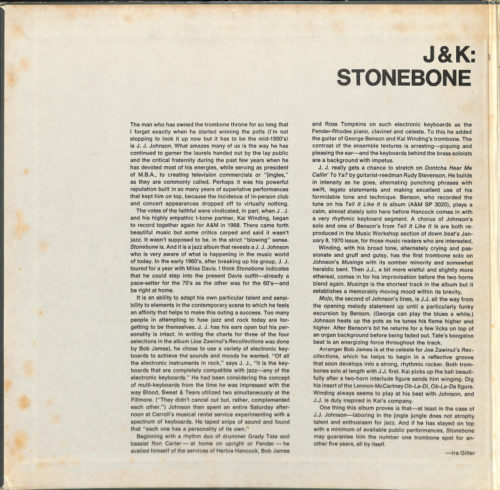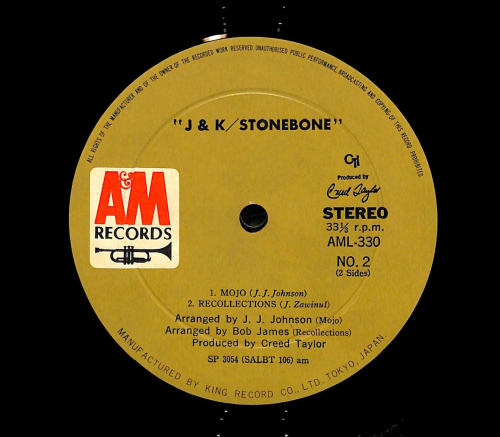Why J. J. Johnson and Kai Winding’s J & K: Stonebone is such a rarity
In 1967, Creed Taylor launched CTI Records as a subsidiary of the A&M label. Taylor had just left Verve, where he headed the jazz label and pioneered new concepts in young-adult jazz, including covers with compelling colour photography and jazz interpretations of pop-rock and pop-soul radio hits. In New York, Taylor had complete autonomy over CTI. Herb Alpert and Jerry Moss (the A and the M) were busy in Los Angeles, and they envisioned CTI as a hip easy-jazz imprint. In 1969, Taylor struck a deal with A&M to leave the label, go off on his own and take CTI with him. At the time, A&M was pinning its hopes on L.A. rock and an expanding variation of pop. They had no problem letting Taylor and CTI leave, since they had bigger fish to fry, including the Carpenters, whom they just had signed.

One of the last jazz albums recorded on the CTI label while still under the A&M umbrella was J & K: Stonebone by J.J. Johnson and Kai Winding. The album’s four songs were recorded in 1969. The reason most CTI fans know little or nothing about the album is that J & K: Stonebone was never released in the U.S. — on vinyl or digitally — and it remains one of CTI’s rarest and priciest eBay purchases.
J & K: Stonebone was released only in Japan in 1970. When I asked Taylor about the album months ago, he couldn’t recall recording it or sending the tapes off to Japan, despite his name and large signature being stamped on the cover as producer.

The album was recorded over three days in September of 1969 at Rudy Van Gelder’s studio in Englewood Cliffs, N.J. It featured Johnson and Winding (trombone), Herbie Hancock and Bob James (electric keyboard), Ross Tompkins (electric keyboard on Recollections), George Benson (guitar), Ron Carter (bass), Grady Tate (drums), with arrangements by Johnson (the first three tracks) and James (Recollections). The songs, in album order, are Dontcha Hear Me Callin’ to Ya, Musings, Mojo and Recollections.

So why wasn’t the album released in the U.S.? The answer rests with three different reasons or all of them combined. First, there were only four tracks on the album, two per side. From a sales perspective, four songs told the target buyer in 1969 that the music on the album was long-winded. Second, the shortest track on the album is a slow ballad that runs just over four minutes, which means there wasn’t an AM radio single, a big sales shortcoming in 1969. Third, each side of the album runs just 18 minutes, which would leave buyers feeling shortchanged at new-album price levels then.
So what happened? Given how many basic rules of Taylor’s own producer playbook the album violated, here are my guesses:
- J & K: Stonebone may have been only halfway finished when Taylor left to set up CTI outside of A&M. If there had been time, I’m sure Taylor would have edited down the longer tracks to get in a couple more commercially viable shorter tracks that could be used on drive-time radio. Or perhaps he didn’t want to edit them down (I wouldn’t have touched them), which still put him in a bind.
- When Taylor left to start CTI as a standalone label, the tapes for J & K: Stonebone likely belonged to A&M, whose executives surely didn’t want to invest more in its production and promotion given its brevity and lack of shorter songs.
- Or maybe J & K: Stonebone took too long to record (three days for four songs seems excessive) and exhausted its budget.
- Or perhaps Taylor let the album go so he could focus on new, more ambitious CTI projects, such as Freddie Hubbard’s Red Clay.
- Or maybe musicians who were on the first three days of recording had to move on to other projects, making them unavailable to record additional planned tracks for J & K: Stonebone.

Now that we have a rough sense of the possible reasons why the album wasn’t released in the U.S., why was it put out only briefly by King Records in Japan?
- I’m guessing that Japan in 1970 wasn’t as driven by radio and singles as the U.S. market, so the commercial risks were lower vs. what King paid to license the album.
- U.S. troops stationed in Japan might have been a stronger market for the jam-oriented LP, since the liner notes by Ira Gitler are in English.
- I’m also guessing that Gitler was commissioned by King for the notes, not CTI; Taylor steadfastly avoided adding liner notes on all of his CTI albums under the belief that they were long-winded and got in the way of listeners enjoying the photos and music.
- A&M or Taylor likely had an established relationship with Japan’s King Records and was able to negotiate a deal to cover the recording expenses.

If you’re asking me to guess about what happened, here’s my take: Taylor didn’t have time to issue the album. He couldn’t take the tape with him because it belonged to A&M. After Taylor left to set up CTI, A&M didn’t want to release the album for a variety of reasons mentioned above. To recoup some or all of the costs of recording, A&M licensed the album to King in Japan, which turned to Gitler for liner notes. The likely reason they printed them in English is that they planned to market the album in the U.S. as an import and they wanted buyers to think it was part of the U.S. catalog.
How is the album today? It’s a superb early psychedelic-jazz release. Johnson and Winding’s trombones function almost like dueling electric guitars, while Benson and the keyboards give the album a jam-session feel. There’s a dreamy quality to J & K: Stonebone and it certainly deserves to be re-issued here now, at least digitally. That would be up to Sony/Columbia, which inherited the CTI catalog. I love this album, and I often listen to it over and over in one sitting. It’s a funky, melodically hypnotic masterpiece and a detailed panoramic snapshot of the jazz-fusion era in its infancy.
How rare is this album? It seems to be going for around $600 in the U.S. If you want the vinyl, try Japanese sites.
But fear not. Here’s the entire album…